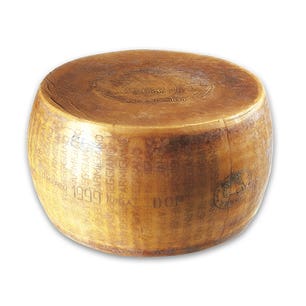The Selection of the Best Parmesan Cheese
Longino & Cardenal is the benchmark for haute cuisine, sophistication and good Made in Italy food. Among the most appreciated hard cheeses of Italy, there is Parmigiano Reggiano, which gets better with aging. Of course, there are so many tasty aged cheeses around Italy, but all over the world Parmesan is the most loved because of its rich taste and a nice texture. You can have parmesan both grated on pasta or simply cut into chunks for an Italian aperitivo, to surprise your family and friends with a special touch of sophistication.
Longino has selected for its customers two types of the best Parmigiano Reggiano available on the market. The two variants of the Italian cheese offered are Luigi Guffanti's Parmigiano Vacche Rosse, which is translated into Red Cows, and the Parmigiano Reggiano di Montagna, meaning parmesan cheese from the mountains, from the Borgotaro company. Both products are of the highest standard, but they differ in specific characteristics found within the Parmigiano rules.
The Red cow produces one-third less milk than other cow breeds. The classic breed is the one used most for the production of the most famous and well-known cheese. The Red cow milk contains a variant of Casein, the most important protein in the process of turning milk into cheese. This element ensures a better and long aging. For this reason, Parmigiano Reggiano Old Cow has a better digestibility.
Parmigiano Reggiano Consortium to protect against falsification
Parmigiano Reggiano is one of the most copied Made in Italy products in the food world. Parmesan cheese from the United States is the symbol of this challenge between the original product and the fake product. The production of fake Parmigiano Reggiano, usually called Parmesan, has surpassed that of the Italian one with the spread of knockoffs, all over the world taking away market space from the Made in Italy symbol.
Parmigiano Reggiano is produced only in the provinces of Parma, Reggio Emilia, Modena, Bologna to the left of the Reno river, and Mantua to the right of the Po river: this is where the farms feed the cattle with local forage, making them grow healthy and strong. This specific diet is given by the Consortium as a form of strict rule in order to guarantee a perfect final product.
How Parmigiano Reggiano is made
The milk from the morning and the previous evening is poured into a copper container, it naturally coagulates with the addition of rennet and a whey starter. To make a Parmesan wheel it takes about 550 litres of milk. The curd is then broken down by the cheese-maker into very small granules using a traditional tool. Then, it's time for the cooking with 55°C, after which the granules sink to the bottom forming a single big mass.
After about fifty minutes the cheese-maker removes the cheese mass for making two twin wheels. Cut into two parts and wrapped in a linen cloth, the cheese is placed in a mould which to give it its final round shape. After a few days, the wheels are immersed in a solution of water and salt: this last passage is very important to end the production cycle of Parmigiano Reggiano and starts its maturation period of 12 months minimum, up to 24, 36, 40 months and more.
How to Prepare a Perfect Parmesan Cream
To prepare a Parmesan cream to perfection, it is important that the Parmesan cheese is finely grated. It is also necessary to have a high quality cream on hand, as well as a saucepan and a whisk.
Follow the steps for the Parmesan Cream recipe:
- Finely grate the Parmesan cheese
- Heat the cream to 85°C.
- Turn off the heat and add the grated Parmesan cheese
- Stir with a whisk until the cream is smooth and homogeneous
- In case lumps have formed, you can blend the cream with an immersion blender and pass it through a fine-mesh strainer.


